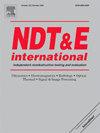Eddy current thermography detection method for internal thickness reduction in ferromagnetic components based on magnetic permeability perturbation
IF 4.1
2区 材料科学
Q1 MATERIALS SCIENCE, CHARACTERIZATION & TESTING
引用次数: 0
Abstract
Eddy current thermography (ECT), as an emerging nondestructive testing (NDT) technique, has been used for defect detection in many critical components. However, the skinning effect of eddy currents limits the ability of ECT to detect internal defects in thick-walled pipes. An ECT detection method for thickness reduction of ferromagnetic components based on magnetic permeability perturbation (MPP-ECT) under DC magnetization is proposed. The thickness reduction cause MPP phenomenon on the surface of ferromagnetic components. Then under high-frequency AC excitation, the thinning area affected by MPP will produce a different thermal response from the normal area, which is recognized and captured by an infrared camera. The mechanism of MPP-based thinning defect detection is analyzed through a theoretical model, and the relationship between thinning thickness, relative permeability and thermal response is established. The feasibility of the MPP-ECT detection method is verified through a series of simulations and experiments. The experimental results show that the method can effectively detect the thinning defect of 4.2 % wall thickness on the back of 12 mm thick specimens. The thermal response of both the thinning and normal areas decreases with increasing magnetization intensity, and the thermal response of the thinning area decreases with increasing thinning thickness. However, the thermal contrast (peak-to-peak value of thermal response) between the two regions increases with the increase of magnetization intensity and thinning thickness. This method can be used for detection under high lift off and weakens the skin effect of ECT for the internal thickness reduction, which has great practical value.
基于磁导率摄动的铁磁元件内部厚度减小的涡流热成像检测方法
涡流热成像技术(ECT)作为一种新兴的无损检测技术,已被用于许多关键部件的缺陷检测。然而,涡流的剥皮效应限制了电痉挛检测厚壁管道内部缺陷的能力。提出了一种基于磁导率摄动(MPP-ECT)的直流电磁感应检测铁磁元件减厚的方法。厚度的减小导致铁磁元件表面出现MPP现象。然后在高频交流激励下,受MPP影响的变薄区域会产生不同于正常区域的热响应,由红外摄像机识别并捕捉。通过理论模型分析了基于mpp的减薄缺陷检测机理,建立了减薄厚度、相对渗透率和热响应之间的关系。通过一系列的仿真和实验,验证了MPP-ECT检测方法的可行性。实验结果表明,该方法能有效检测出12 mm厚试样背面4.2%壁厚的变薄缺陷。随磁化强度的增加,薄化区和正常区热响应减小,薄化区热响应随薄化厚度的增加而减小。然而,随着磁化强度的增加和减薄厚度的增加,两个区域之间的热对比(热响应的峰对峰值)增加。该方法可用于高升力下的检测,并能减弱ECT对内部减厚的集肤效应,具有较大的实用价值。
本文章由计算机程序翻译,如有差异,请以英文原文为准。
求助全文
约1分钟内获得全文
求助全文
来源期刊

Ndt & E International
工程技术-材料科学:表征与测试
CiteScore
7.20
自引率
9.50%
发文量
121
审稿时长
55 days
期刊介绍:
NDT&E international publishes peer-reviewed results of original research and development in all categories of the fields of nondestructive testing and evaluation including ultrasonics, electromagnetics, radiography, optical and thermal methods. In addition to traditional NDE topics, the emerging technology area of inspection of civil structures and materials is also emphasized. The journal publishes original papers on research and development of new inspection techniques and methods, as well as on novel and innovative applications of established methods. Papers on NDE sensors and their applications both for inspection and process control, as well as papers describing novel NDE systems for structural health monitoring and their performance in industrial settings are also considered. Other regular features include international news, new equipment and a calendar of forthcoming worldwide meetings. This journal is listed in Current Contents.
 求助内容:
求助内容: 应助结果提醒方式:
应助结果提醒方式:


